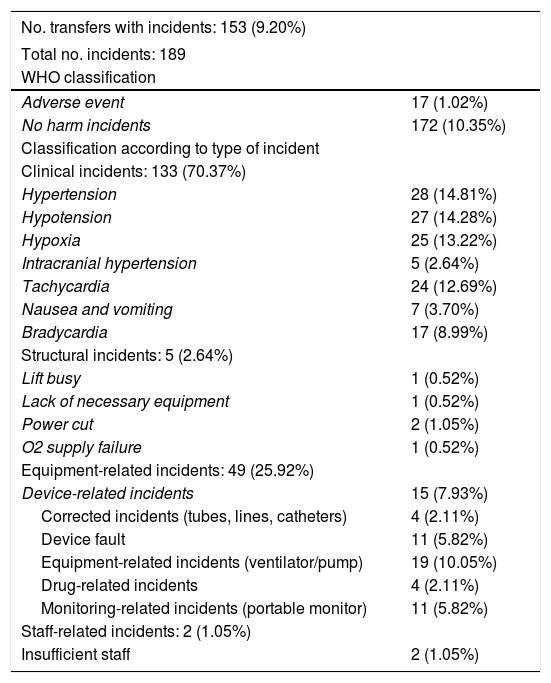The main objective of our study is to determine if the implementation of an HIT protocol modifies the annual rate of incidents related to patient safety. The secondary objectives are, firstly, to classify the identified events, secondly to analyse the factors that are associated with the presence of said adverse events and finally to analyse the degree of monitoring of the protocol.
Material and methodsRetrospective descriptive analysis that included patients admitted to the Intensive Care Unit who required HIT between 2009 and 2018. A multidisciplinary protocol was developed and the incidents were classified according to the severity and type of events.
ResultsWe included 1662 transfers. The total number of transfers with incidents was 153 (9.2%) in which 189 incidents were registered, of which 17 (9%) were described as adverse events (AD), while 172 (91%) were classified as Incidents without Damage (IsD). The clinical incidents were the most frequent (70.37%). In the multivariate analysis we found as associated factors cardiac arrhythmias (OR: 2.88, [IQR 2.01–4.12]), history of stroke (OR 1.72 [IQR 1.06–2.78]) and anaemia (OR 1.55 [IQR 1.02–2.37]).
The rate of safety-related incidents was less over time as adherence to protocol compliance increased.
ConclusionsThe implementation of a critical patient transport protocol and its application through checklists allows to reduce both the incidence of adverse events in these patients and of Incidents without Damage.
El objetivo principal se centra en determinar si la implantación de un protocolo de traslado intrahospitalario (TIH) modifica la tasa anual de incidentes relacionados con la seguridad del paciente. Los objetivos secundarios son, en primer lugar clasificar los eventos identificados, en segundo lugar analizar los factores que se asocian a la presencia de dichos eventos adversos y por último analizar el grado de seguimiento del protocolo.
Material y métodosAnálisis descriptivo retrospectivo que incluyó pacientes ingresados en la Unidad de Cuidados Intensivos que requirieron TIH entre 2009 y 2018. Se desarrolló un protocolo multidisciplinar y se clasificaron las incidencias según la gravedad y el tipo de eventos.
ResultadosSe incluyeron 1662 traslados. El número total de traslados con incidentes ha sido 153(9,2%) en los que se han registrado 189 incidentes, de los cuales 17(9%) fueron descritos como eventos adversos (EA), mientras que 172(91%) se clasificaron como Incidentes sin Daño(IsD). Las incidencias clínicas fueron las más frecuentes (70,37%). En el análisis multivariante encontramos como factores asociados las arritmias cardíacas (OR:2,88, [IQR 2,01–4,12]), antecedentes de accidente cerebrovascular (OR 1,72 [IQR 1,06–2,78]) y anaemia (OR 1,55 [IQR 1,02–2,37])
La tasa de incidentes relacionados con la seguridad fue menor a lo largo del tiempo a medida que aumentaba la adhesión a la cumplimentación del protocolo.
ConclusionesLa implementación de un protocolo de transporte del paciente crítico y su aplicación mediante listas de verificación permite reducir tanto la incidencia de eventos adversos en estos pacientes como de IsD.












